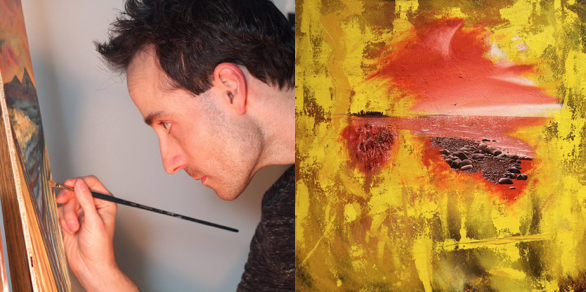Virtual Studios (4): Implementing a Virtual Studio: An Interview with Elijah Van Benschoten

Online teaching advice from an expert on digital studios: “Without clearly defined class times, it’s really tough to both invest too little or too much time in classes”.
Prompted by the 2019 Innovating Pedagogy Report, this post series has endeavored to provide a dive into the world of virtual studios. The first post in the series introduced studios and studio pedagogy. The second post examined high-level practices using the internet to transition the studio more from a standard studio to a virtual studio. The third post contained a discussion of specific software/platforms to use when implementing a virtual studio. If you missed any of the previous installments in the virtual studio series, be sure to check them out in the AACE Review archives.
In this final post, I will conclude with an interview with Elijah Van Benschoten, an art and design educator who, though formally works for South Dakota State University, actually lives several hundred miles away in Ohio. This academic anomaly is possible because his teaching studio is of the virtual variety. In this interview, Elijah offers valuable insight into the benefits and challenges that come with a virtual studio and also shares some unexpected quirks encountered along the way. To learn more about Elijah’s art practice and teaching philosophy, please visit his website: http://www.evanbens.com
What does education in your discipline traditionally look like?
Probably the standard 3 hour twice-per-week studio time with a course on each medium and project-driven curriculum.
How are you using virtual studio practices?
One of my primary goals is replicating the studio experience as much as possible. The projects are broken up into week-by-week modules with the same sort of assignment sheets and demos that you’d experience in an in-person class, but everything is sort of on-demand with videos.
How has implementing a virtual studio changed the dynamics of your teaching space?
My home is my fulltime classroom now, and there’s certainly been a learning curve with how to make it feel more like a real classroom. Initially, I set up my home office/studio with the standard desk and laptop but grew to hate being so sedentary. Now, I do the vast majority of my work on a treadmill either walking or standing. In-person teaching required so much physical moving and interacting, which is kind of simulated with exercise equipment. One of my favorite habits is to read and interact with the course discussions on an iPad while pedaling on my recumbent stationary bike. I’ll play music that I’d play in a classroom but never put on something to watch, which is something I’d forbid whenever teaching in a physical classroom.
Are there any specific tools or software platforms you have found to be especially helpful or useful?
Mobile devices, in general, have become more and more useful for keeping up with my online classes. D2L’s Pulse app has gotten better lately with making it easier to do non-grading activities in the classes, too. Quite often I’ll check on discussions on my phone while waiting for something or while my son watches TV since all it requires is just whipping out my phone.
What benefits do you perceive come from a virtual studio?
Flexibility is the clearest benefit by far. If I have to move to another town, my classes come with me. If I have to go out of town for a few days, I don’t miss any classes. If my family’s schedule changes radically, I can change my usual working times. I also don’t miss having a daily commute, which just felt like an utter waste of time going to and from my class location.
What challenges do you perceive come from a virtual studio?
Without clearly defined class times, it’s really tough to both invest too little or too much time in classes. There’s always something to tweak, update, change, and whatnot on top of the usual grading and communicating needs of a course. Time management is something that consistently looms in the back of my mind. Got to make sure I’m grading stuff within the time frame that I’ve promised. Got to make sure I respond to students quickly if they have a question or problem. As a side note, I’m looking forward to when technology will allow me to be physically available in virtual form on campus for students to simply drop by my office if they need something–kind of like the doctor on Star Trek Voyager or George Bluth’s surrogate in season 3 of Arrested Development. Had to throw in a couple of nerdy references since my brain works in TV and movie references.
What advice do you have for someone who is thinking about augmenting or even replacing their face-to-face studio with virtual studio elements?
Start from the perspective of what you’d want it to look like as a student taking the course. Try to design everything around making it as accessible and as easy to follow as possible for students. While it might be annoying to produce, having redundancy in how students access the information (video + written info) is supremely helpful. It’s also direly important to constantly emphasize the importance of communication with the students. Since they can’t just raise their hand in class (which is sometimes hard enough for some of them) they need to know that they’ll get what they need from the instructor however they reach out.
About
 As a painter, drawer, printmaker, and photographer, Elijah Van Benschoten maintains a vigorous multidisciplinary studio practice as well as an active college teaching career. His work has been shown in galleries and museums across fifteen states and on two continents. Originally a Michigan native, Elijah has taught at various schools in New York, South Dakota, Nebraska, Kentucky, Michigan, and Ohio. He currently resides in Cincinnati and teaches online at South Dakota State University.
As a painter, drawer, printmaker, and photographer, Elijah Van Benschoten maintains a vigorous multidisciplinary studio practice as well as an active college teaching career. His work has been shown in galleries and museums across fifteen states and on two continents. Originally a Michigan native, Elijah has taught at various schools in New York, South Dakota, Nebraska, Kentucky, Michigan, and Ohio. He currently resides in Cincinnati and teaches online at South Dakota State University.